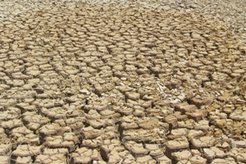Extreme weather events fuel climate change - Extreme meteorological events and global warming: a vicious cycle?
When the carbon dioxide content of the atmosphere rises, the Earth not only heats up, but extreme weather events, such as lengthy droughts, heat waves, heavy rain and violent storms, may become more frequent. Whether these extreme climate events result in the release of more CO<sub>2</sub> from terrestrial ecosystems and thus reinforce climate change has been one of the major unanswered questions in climate research. It has now been addressed by an international team of researchers working with Markus Reichstein, Director at the Max Planck Institute for Biogeochemistry in Jena. They have discovered that terrestrial ecosystems absorb approximately 11 billion tons less carbon dioxide every year as the result of the extreme climate events than they could if the events did not occur. That is equivalent to approximately a third of global CO2 emissions per year.

The indications that the part played by extreme weather events in the carbon balance had been underestimated prompted scientists from eight countries to launch the CARBO-Extreme Project. For the first time, the consequences of various extreme climate events on forests, bogs, grass landscapes and arable areas throughout the world underwent systematic scrutiny.
Satellites and recording stations document extreme events
The researchers working with Markus Reichstein took different approaches to their study from the ecosystem perspective. Satellite images from 1982 to 2011 revealed how much light plants in an area absorb so that they can perform photosynthesis. From this, they were able to determine how much biomass the ecosystem in question accumulates during or af-ter an extreme weather event. The researchers also used data from a global network of 500 recording stations, some in operation for more than 15 years, which record carbon dioxide concentrations and air currents in the atmosphere a few meters above ground or in forest canopies. Calculations from these values indicate how much carbon an ecosystem absorbs and releases in the form of carbon dioxide.
The team then fed the various readings into complex computer models to calculate the global effect of extreme weather on the carbon balance. The models showed that the effect is indeed extreme: on average, vegetation absorbs 11 billion fewer tons of carbon dioxide than it would in a climate that does not experience extremes. "That is roughly equivalent to the amount of carbon sequestered in terrestrial environments every year," says Markus Reichstein. "It is therefore by no means negligible."
Droughts hit vegetation particularly hard
Droughts, heat waves, storms and heavy rain have not yet become dramatically more frequent and pro-nounced as a consequence of anthropogenic climate change. However, many climate re-searchers expect that they will in the future. This would mean more carbon dioxide in the atmosphere as a result of extreme weather conditions.
Periods of extreme drought in particular reduce the amount of carbon absorbed by forests, meadows and agricultural land significantly. "We have found that it is not extremes of heat that cause the most problems for the carbon balance, but drought," explains Markus Reich-stein. He and his colleagues expect extreme weather events to have particularly pronounced, varied and long-term effects on forest ecosystems. Drought can not only cause immediate damage to trees; it can also make them less resistant to pests and fire. It is also the case that a forest recovers much more slowly from fire or storm damage than other ecosystems do; indeed, grasslands are completely unaffected by high winds.
The researchers also discovered that serious failures to absorb carbon are distributed ac-cording to a so-called power law, like avalanches, earthquakes and other catastrophic events. This means that a few major events dominate the global overall effect, while the more frequent smaller events occurring throughout the world play a much less significant part.
Weather extremes are still very rare, but more research is needed
The researchers are planning more studies to improve their understanding of the conse-quences of extreme events. For example, they want to investigate the way the different ecosystems respond in laboratory and field experiments. "These experiments have already been carried out, but mostly they only look at extreme events which occur once in a 100 years," explains Michael Bahn, a project partner from the University of Innsbruck. "We should also take account of events which so far have only happened once in 1,000 or even 10,000 years, because they are likely to become much more frequent towards the end of this century." The researchers are also suggesting that, in a drought or a storm, satellites be directed at the area in question as quickly as possible so that the immediate effect can be recorded along with the long-term impact.
The investigations of the current study, however, show that the consequences of weather extremes can be far-reaching. "As extreme climate events reduce the amount of carbon that the terrestrial ecosystems absorb and the carbon dioxide in the atmosphere therefore continues to increase, more extreme weather could result," explains Markus Reichstein. "It would be a self-reinforcing effect."
The research into extreme weather events was undertaken over a period of four years as part of the CARBO Extreme Project by the European Commission in the 7th Framework Pro-gramme and coordinated by the Max Planck Institute for Biogeochemistry in Jena.
